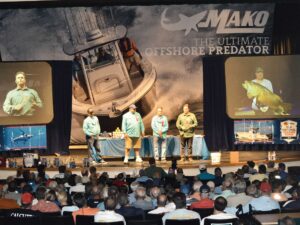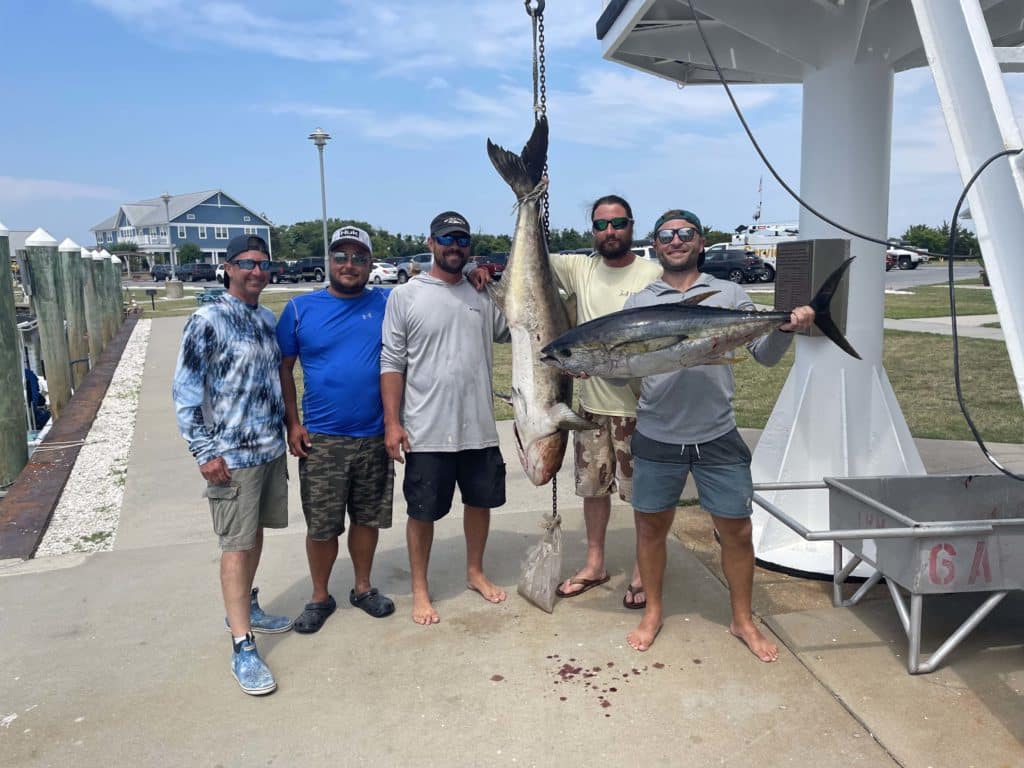
A Delaware angler who had never caught a cobia before this summer made his first one count in a big way, hooking an 89-pounder that shattered the existing state record by 10 pounds.
Scott Brooks, of Hockessin, was headed back to Indian River Inlet Marina on July 15 after a morning jigging for bluefin tuna 30 miles offshore when he spied schools of bunker “as big as football fields” swimming a couple of miles off the beach.
Brooks and his boatmates, who included his cousin Jesse Coulbourn and brother-in-law Andrew Farach, had cut short their offshore outing because of approaching weather. With the storm past and the baitfish swarming, they decided to stop and cast to the edges of the massive schools to see what they could turn up. “Honestly, we thought it would be bluefish,” Brooks told Salt Water Sportsman. “A giant cobia wasn’t on the radar at all.”
Brooks grabbed a Penn Spinfisher VI rod rigged for bluefin, tied on a bucktail jig and pitched it out, demonstrating his jigging technique to Farach, a less-experienced angler. “I said to Andrew, ‘Watch this; this is what you do,’ and all of a sudden my rod was pinned over and the fight was on.”
The cobia hammered the lure fairly close to the boat, and Brooks was initially able to gain line with little effort. “He came in easy at first, because I don’t think he really knew what was going on,” he says. “When he got close to the boat and realized what was up, he just dove for the bottom as hard as he could go.”
Before the fish disappeared, however, the anglers also got their first look—and were impressed.
Big Delaware Cobia Sets Record
“My cousin looked at me and said, ‘Dude, that’s the biggest cobia I’ve ever seen in my whole entire life,’” Brooks recalls. “He had just spent a whole day catching 50-pounders in Virginia, and this one was twice their size. That’s when the stress level went up and things got crazy.”
The Spinfisher was rigged with a Penn Slammer IV 8500 reel spooled with 65-pound braid. “The fish was pulling 25, 30 pounds of drag with no problem at all,” Brooks says, “and he basically went down as far as he could. Probably about 60 feet. I’d work him back up and he’d dive again. He did that two or three times.”
The 45-minute fight was a “total team effort,” according to Brooks. He was on the rod for the entire battle, but Coulbourn, whose 23-foot Regulator they were fishing on, wielded a gaff. Pat Miles drove the boat and eventually manned a second gaff; Drew Henninger leant support and advice; and Farach snapped photos.
“Once we got it in the boat, everybody was hooting and hollering and the excitement was through the roof,” Brooks recalls. “My cousin said, ‘If that’s not a world record, it’s gotta be a state record.’ And then Andrew got on his phone and started Googling.”
The cobia—which they were estimating at around 100 pounds—wasn’t near the IGFA world record mark of 135 pounds, 9 ounces, caught in Shark Bay, Australia, in 1985. But it did appear to have a shot at the Delaware state record, a 79-pound, 6-ounce fish from August 2018.
The group headed to Hook ‘Em and Cook ‘Em, a bait shop in Indian River Marina, where their first attempt to weigh the fish didn’t attract much interest from the staff, who directed Brooks to a platform scale too small to hold the 63-inch cobia. But once they got the fish properly hung and weighed, they knew they had something special.
“We made an agreement that we weren’t going to make a big scene,” Brooks says of their bait shop appearance. “But after the weighing, we knew and the shop owner knew we had beaten the record. It was exciting—hugs and high fives and all that stuff—and there was a crowd of people, because everybody loves a big fish.”
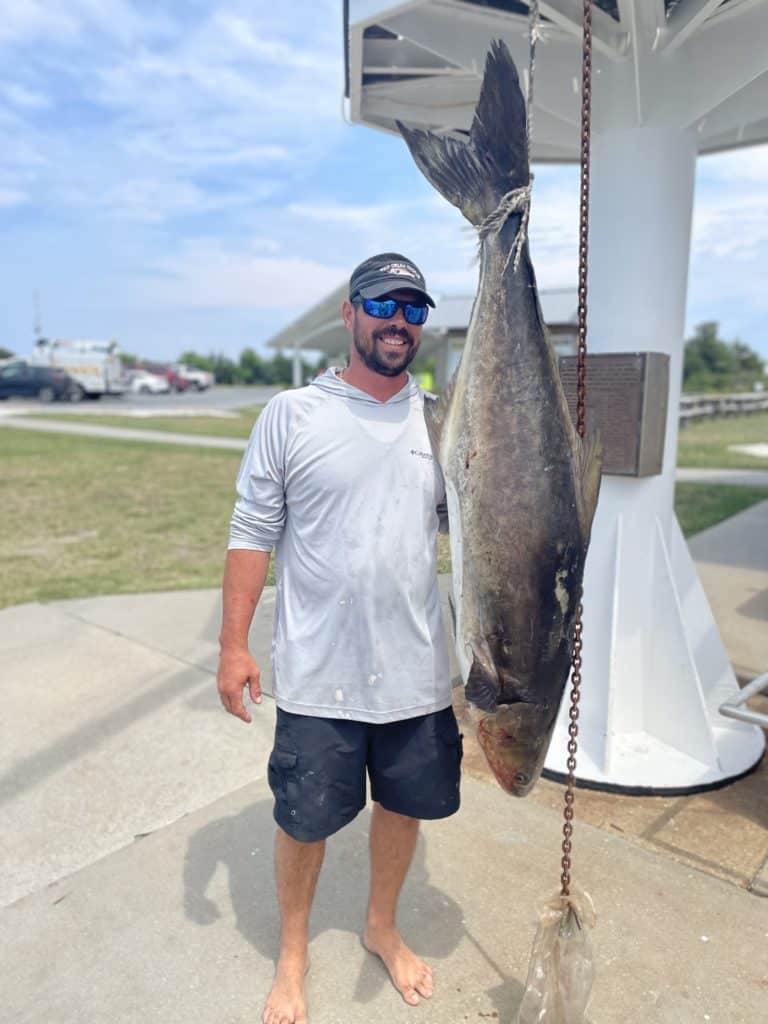
Cobia Expand Range North Along Atlantic Coast
Brooks’ catch is the second state-record cobia this summer in a region not traditionally known as a hotspot for Rachycentron canadum. The only living member of the family Rachycentridae, cobia are found in tropical and warm temperate waters around the world. But in recent years significant sightings of the hard-fighting fish have been reported in New York, Delaware and Connecticut.
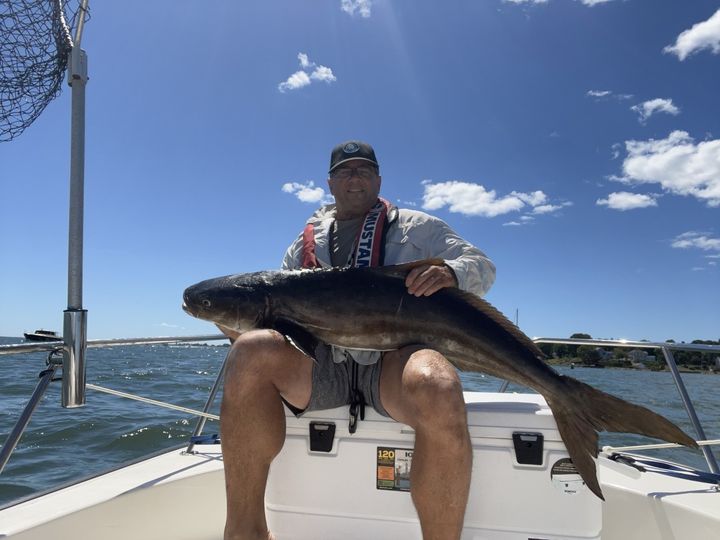
In August, John Bertolasio caught a 44-pound, 56-inch cobia while fishing a dead eel on Long Sand Shoal, setting a new Connecticut state record. Connecticut Fish and Wildlife congratulated Bertolasio “for his amazing catch of a species of fish that is normally found in waters far south from here,” noting in a Facebook post that “encounters with southern species, like cobia, are becoming more and more frequent in Long Island Sound due to Climate Change.”
Delaware did not even have a state record category for cobia until 2018. But in recent years, the fish have been showing up in Brooks’ home waters with greater regularity.
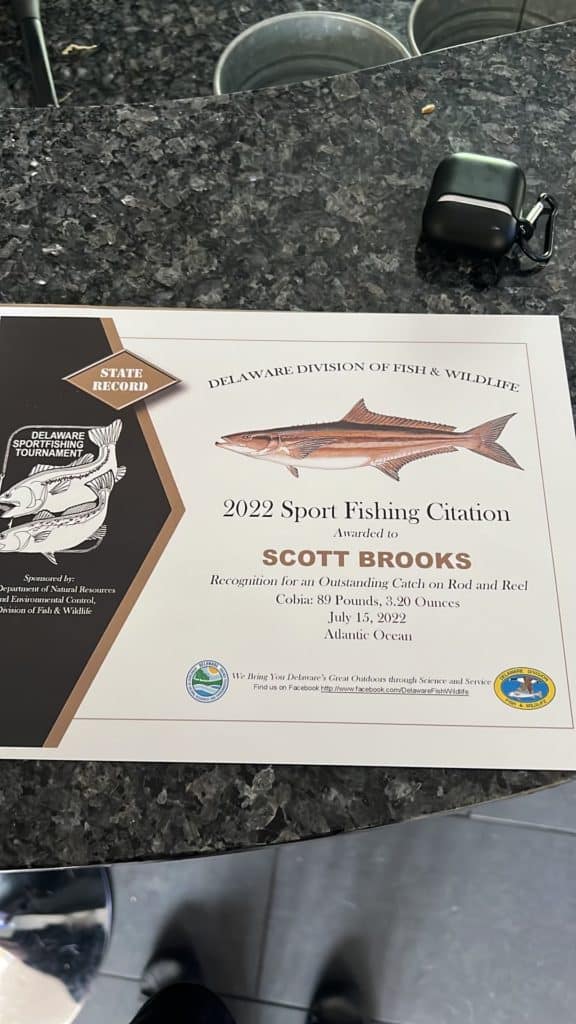
“They almost used to be a myth around here,” he says. “Someone would tell you they caught a cobia you’d be like, ‘Yeah, right.’ Someone would say they were going fishing for cobia, and you’d be like, “What for?’ But within the last five, six years, they’re coming around more, and cobia fishing is a legit thing to do now.”
Noting that water temperatures can change from year to year, Brooks offers a different theory for their expanding territory.
“I think that our fishing practices have changed, which allows more fish,” he says. “Now they’re starting to spread out a little bit more, whereas before they were probably just being overfished where they were and couldn’t really spread.”
In September 2021 Delaware and other states set new possession and length limits (one fish per angler or per vessel; minimum length 37 inches in Delaware) to comply with Federal regulations shifting management of Atlantic cobia from the National Oceanic and Atmospheric Administration to the Atlantic States Marine Fisheries Commission. The shift was made because the majority of cobia were being caught in state waters.




